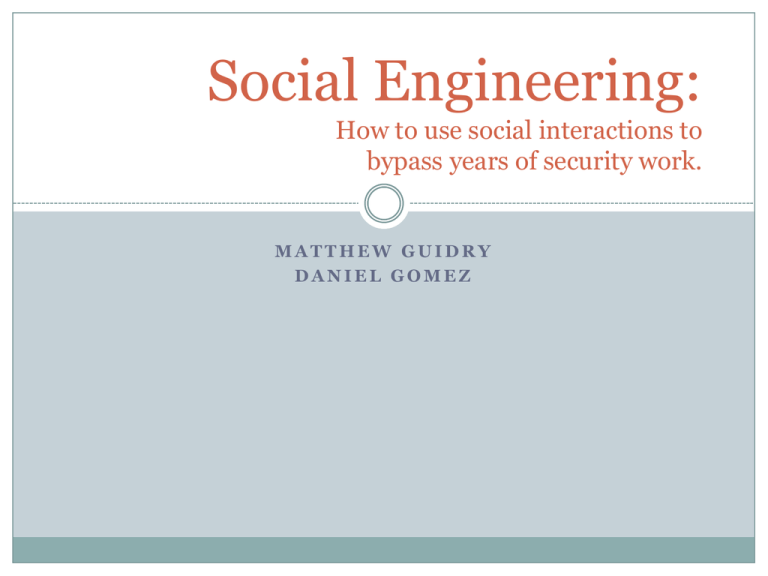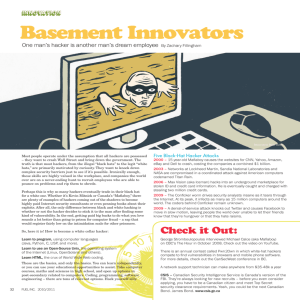Social Engineering - Florida State University
advertisement

Social Engineering: How to use social interactions to bypass years of security work. MATTHEW GUIDRY DANIEL GOMEZ A True Example of Social Engineering What Really is the Weakest Link?? Cryptography has come a long way. Breaking into a server from outside the system is constantly becoming more and more difficult. Security at the system level is usually enforced Weak passwords are not allowed and passwords must be updated often. The most effective approach is by exploiting the people using the system. Social Engineering Definition: An outside hacker’s use of physiological tricks on legitimate users of a computer system, in order to obtain information he needs to gain access to a system. The hacker’s goal is to obtain information that will allow him/her to gain unauthorized access to a valued system and the information that resides on it. Social Engineering The key to maintaining the Confidentiality, Integrity, and Availability of an organization’s information is controlling who accesses what information. This is accomplished by being able to identify the requestor, verifying the requestor is not an imposter, and ensuring the requestor has the proper clearance level for the information being requested. Three Steps process to ensure C.I.A. against Social Engineering attacks: Identification Authentication Authorization - “Do I know you?” - “Are you who you say you are?” - “Are you suppose to be here?” Identification There are numerous examples of attempted and achieved impersonations. These usually involve assuming a vulnerable or trusted authority. Impersonating a new member to an organization. Impersonating an actual member (or ranking member) of an organization. Impersonating a vendor there to perform a service Impersonating an IT member/ IT supervisor Impersonating a customer Impersonating a service provider for that organization Identification Security is all about trust. Trust in protection and authenticity. Generally agreed upon as the weakest link in the security chain, the natural human willingness to accept someone at his or her word leaves many systems and companies vulnerable to attack. Authentication After you have told the target who you are, you must have the tools to convince them of that fact. There are a list of tools commonly used to achieve this measure: Jargon used at the corporation that no one else would know Technical terms an IT or supervisor would use Knowing names of people within the organization or other companies that work with the organization Having some form of identification that the person will not be able to readily look up Authorization Once they have convinced the target that they are who they claim to be, sometimes hackers must be convincing that they have rights to the requested materials. • Empathy: Techniques which motivate the person to feel sorry for them such as a new employee, guest, or someone having a bad day to authorize them. • Fear: The hacker may present themselves as a boss or someone of authority to motivate the release of information or entrance. • Pride: Giving someone a sense of pride that they were able to help you with your request. Alternatives Other than attempting to bypass the IAA Test (Identification, Authentication, Authorization). Hackers may try a few other strategies. Psychological Convincing- Causing Mental Shortcuts Social Proof- Bandwagon technique Similarity- Finding a common grounds in order to get information It is important to remember that even those on the watch for “social hackers” will be more inclined to release privileged information to persons assuming particular roles. Such as a police officer or an IT Technician. Social Engineering for the Perfect Grade! If I portrayed myself to be a T.A. for the teacher of this class in another class which you took, would that help you to give me a 10 exchange for a possible better grade in that class? The Social Engineering Cycle Cycle until you have enough Attack It is key not to ask one Research Developing Trust Using the Trust Exploiting Trust person for too much information at a time and seem suspicious You do not want to “burn” them (they are your minions) What does one look for? What is useful? Names of key people within a corporation When targeted people will be on vacation Names of children, spouses, or pets. Used to establish a relationship or often these are ill-selected passwords. Helpful hints that may have been left on carelessly discarded memos. Calendars discarded from the previous year. Other things that are found in trash It is important to share as little information with others as possible. The more they know, the more they can use for a later attack. CAUTION! In WWII the US government put posters up in an effort to jog employee memories. Stealing Information If you wanted to capture and use someone’s credit card, forget about stealing their wallet or purse. A social engineer will simply call and ask the person, pretending to be their work or bank, and ask for their card number, billing address, social security number, or even their mother’s maiden name. Reverse Social Engineering Let someone know that they might encounter a problem in the future. Let them know you can help them if that situation ever did arise Purposely invoke that problem to happen. The victim will call you asking you for help. Now you have the upper hand in the situation’ Example The Social Engineer has control of a small network switch. He/She tells the users on that switch to call him if they encounter any network problems. Then he turns off the switch and waits for a call from them. While he is “helping” them with the network problem he/she tries to gain information from the user (i.e. server names, usernames, etc …) Defenses: How to stop a Social Engineering Attack As discussed before Social Engineers function by passing 3 principles IAA (Identification, Authentication, and Authorization) Thus, the best way to defend against attacks is to pay close attention to these areas. Defending Tactics IDENTIFICATION Who are you? Do I know you? IF NOT Ask for their name AUTHENTICATION Are you who you say you are? Ask for some sort of Identification ID badge Picture ID Defending Tactics Cont’d AUTHORIZATION Are you allowed to do this? Ask who authorized this action Ask for their name again Is this a reasonable request? Are you supposed to be here? Was the maintenance guy supposed to come by today? Additional Ask Bogus Questions! Either they will correct you and tell you you are wrong OR they will build on the fake knowledge – BUSTED! Securing your Workplace Instanciate/Add security procedures/policies that Inhibit standard Social Engineering tactics If password is required, never give out over the phone or email Invoke separation of Duty (This increases the number of steps for the Social Engineering, thus making it harder) Release as little information as possible. Train your Employees that handle sensitive data Make them aware of the Social Engineering Construct. Teach them common methods used by social engineers. Supply them with a model of security procedures Start the employee off with smaller duties until they are more familiar with the security features. Famous Social Engineers Kevin Mitnick Made free phone calls Obtained full admin rights to an IBM computer at the Computer Learning Center in Los Angeles… just in order to win a bet Used the Los Angeles bus transfer system to get free rides Hacked into NEC, Nokia, Sun Microsystems, Motorola and Fujitsu Siemens systems. Allegedly hacked attempted hacking into the Pentagon over the ARPAnet from a terminal room at the University of Southern California He wrote a book “The Art of Deception” which is a leading book for Social Engineering. We used some of his warnings in our research. Examples Online Sweepstakes – users enter passwords that may be used in other places. These may then be used in offices to enter computers or other functions within a company. Using similar domain names. The Movie “ Catch Me If You Can” References: McDowell, Mindi "Avoiding Social Engineering and Phishing Attacks" US-CERT. Retrieved on 31 March 2010 from <http://www.us-cert.gov/cas/tips/ST04-014.html> Mitnick, K & Simon, W (2002) The art of Deception: Controlling the human element of security. Indianapolis, Indiana: Wily Publishing, Inc pg. 332 Tim Thornburgh " Social Engineering: The "Dark Art" "Kennesaw State University, GA. Rusch, J The "social engineering" of Internet fraud." Published on Internet Society. Retrieved March 30th 2010 from <http://www.isoc.org/inet99/proceedings/3g/3g_2.htm> David Gragg (December 2002) "A multi-Level Defense Against Social Engineering" SANS Institute. Retrieved on 01 April 2010 from <http://www.sans.org/reading_room/whitepapers/engineering/multi-level-defense-socialengineering_920> CNN (October 13th 2005) "A convicted hacker debunks some myths" CNN Website. Retrieved on 02 April 2010 <http://www.cnn.com/2005/TECH/internet/10/07/kevin.mitnick.cnna/>





